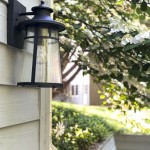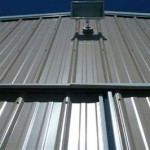Outdoor Lights with PIR and Manual Override: Enhancing Security and Convenience
Outdoor lighting plays a crucial role in enhancing the security, safety, and aesthetic appeal of residential and commercial properties. Among the various types of outdoor lights available, those equipped with Passive Infrared (PIR) sensors and manual override functionality offer a blend of automated control and user-defined customization. This article examines the features, functionalities, benefits, and practical considerations associated with outdoor lights incorporating both PIR sensors and manual override capabilities.
A PIR sensor, also known as a motion sensor, detects changes in infrared radiation emitted by objects in its field of view. Since all objects with a temperature above absolute zero emit infrared radiation, a PIR sensor can identify movement by detecting variations in the infrared signature of its surroundings. When movement is detected, the sensor triggers the light to turn on automatically. This automated activation serves as a deterrent to potential intruders, improves visibility in dark areas, and provides convenience for residents and visitors.
Manual override functionality, in contrast to the automated operation of the PIR sensor, allows users to manually control the light, irrespective of motion detection. This feature provides flexibility in situations where continuous illumination is desired, such as during social gatherings, outdoor activities, or for prolonged security surveillance. The ability to override the PIR sensor and manually turn the light on or off offers a level of control beyond the standard motion-activated behavior.
Understanding PIR Sensor Technology
The core of a PIR-enabled outdoor light is the PIR sensor itself. This sensor typically consists of two pyroelectric sensors arranged side-by-side. Each sensor is sensitive to infrared radiation, but they are wired in such a way that they cancel each other out when they detect the same level of radiation. When a warm object, like a person or animal, moves within the sensor's field of view, it first triggers one pyroelectric sensor and then the other. This difference in infrared radiation between the two sensors creates an electrical signal, which is then amplified and used to activate the light.
The sensitivity and range of a PIR sensor are crucial factors in determining its effectiveness. Sensitivity refers to the sensor's ability to detect subtle changes in infrared radiation. A highly sensitive sensor can detect movement from a greater distance and is less likely to be triggered by smaller animals or minor environmental variations. Range, on the other hand, defines the maximum distance at which the sensor can reliably detect movement. PIR sensor range is typically expressed in meters or feet and is often adjustable to suit the specific needs of the installation.
Several factors can affect the performance of a PIR sensor. Environmental conditions, such as temperature and humidity, can influence the sensor's sensitivity. Obstructions, like trees or bushes, can block the sensor's field of view and limit its range. The mounting height and angle of the light also play a role in determining the sensor's coverage area. Proper placement and adjustment of the PIR sensor are essential for optimal performance.
Modern PIR sensors often incorporate advanced features to improve their accuracy and reliability. These features may include adjustable sensitivity settings, multiple detection zones, and pet-immune technology. Adjustable sensitivity allows users to fine-tune the sensor's response to minimize false alarms. Multiple detection zones divide the sensor's field of view into smaller segments, allowing for more precise detection of movement. Pet-immune technology uses algorithms to differentiate between human and animal movement, reducing the likelihood of the light being triggered by pets.
Exploring Manual Override Options
The manual override feature provides users with the ability to bypass the PIR sensor and control the light manually. This functionality is typically implemented using a switch or a series of on/off cycles. The specific method for activating the manual override varies depending on the manufacturer and model of the light.
One common method involves quickly switching the light on and off a specific number of times. For example, switching the light off and on twice within a few seconds may activate the manual override mode, causing the light to stay on continuously. To return to the PIR sensor-controlled mode, the user would typically repeat the same sequence of on/off cycles or simply turn the light off and then back on.
Another method involves using a dedicated switch or button on the light fixture. This switch allows users to easily toggle between the PIR sensor mode and the manual override mode. This approach offers a more straightforward and intuitive way to control the light's operation. Some advanced models may even allow users to program the duration of the manual override mode, allowing the light to stay on continuously for a predetermined period, such as one hour or several hours.
The manual override feature can be particularly useful in various situations. For example, when hosting an outdoor party or barbecue, users can activate the manual override mode to ensure that the light stays on continuously throughout the event. Similarly, during a power outage, the manual override feature can be used to temporarily activate the light using battery backup power, providing illumination in the absence of mains electricity. In situations where security is paramount, the manual override feature can be used to maintain continuous illumination, deterring potential intruders.
Advantages and Practical Considerations
Outdoor lights with PIR sensors and manual override offer several advantages over traditional outdoor lighting systems. These advantages include enhanced security, improved energy efficiency, increased convenience, and greater flexibility. The motion-activated illumination provided by the PIR sensor serves as a deterrent to potential intruders and improves visibility in dark areas. The automatic shut-off feature helps to conserve energy by ensuring that the light only turns on when needed. The manual override feature provides users with the ability to customize the light's operation to suit their specific needs and preferences.
From an energy efficiency perspective, PIR-enabled lights significantly reduce energy consumption compared to lights that remain on continuously. By only activating illumination when motion is detected, they minimize unnecessary energy waste. This can result in substantial cost savings over time, particularly when using LED bulbs, which are known for their energy efficiency and long lifespan.
Installation of outdoor lights with PIR sensors and manual override is generally straightforward, especially for models that are designed for DIY installation. However, it is important to follow the manufacturer's instructions carefully to ensure proper wiring and mounting. The location of the light is also critical for optimal performance. The light should be positioned to provide adequate illumination to the desired area while avoiding obstructions that could block the PIR sensor's field of view.
Maintenance requirements for these lights are typically minimal. Regular cleaning of the lens and sensor can help to ensure optimal performance. Periodic inspection of the wiring and connections is also recommended to prevent corrosion or damage. Replacing bulbs or batteries as needed is another routine maintenance task. Choosing durable and weather-resistant materials for the light fixture can also help to extend its lifespan and reduce the need for frequent maintenance.

Stainless Steel Outdoor Wall Up Down Pir Light Manual Override

Stainless Steel Outdoor Wall Down Pir Light Manual Override 25 Off

Palin Stainless Steel Outdoor Pir Wall Down Light Manual Override 75431

Traditional Led Outdoor Pir Wall Lantern Manual Override Black Ip54

Alessandra Ip44 Rated Pir Sensor Outdoor Wall Light 3427gp The Lighting Super

Steinel L 115 S White Classic Outdoor Wall Light Pir Motion Sensor Glass Globe Soft Manual Override Diy At B Q

Lonstrup Outdoor Pir Light 7143 20 31 The Lighting Super

Ip44 Exterior Pir Movement Operated Up And Down Wall Light For Gu10 Bulbs With Manual Override

Pir Infrared Motion Sensor Black Outdoor 360 Degree Manual Override Ip65

Ip44 Exterior Pir Movement Operated Up And Down Wall Light For Gu10 Bulbs With Manual Override
Related Posts







